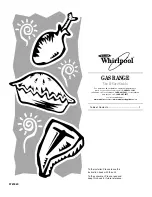
23
CONVECTION COOKING TIPS
For Convection Models
To learn how to use your convection oven to the best
advantage, refer to
Convection Cooking
on page 23.
1. The fan-forced hot air movement permits baking and
roasting on as many as 3 levels at once.
2. The Delay feature can not be used when using
Convection
for baked items e.g.…pies, cakes, cookies.
3. There should be a minimum of 1” (2.5 cm) between
the walls and the pans used.
4. Position food in oven to allow free flow of air around
the convection fan.
5. Uniform spacing of baking dishes will produce the
most even results.
6. Place bread pans lengthwise facing the oven door.
7. Do not use aluminum foil for convection baking. It
may block airflow.
8. True convection cooking is used for baking breads,
cakes and other foods which require gentle heating.
This setting is also recommended when baking large
quantities of food on more than one rack.
Convection cooking creates more moisture in the
kitchen than normal, usually because more food is
being cooked at one time. We suggest that the exhaust
blower be set on low when convection cooking.
9. For convection roasting, do not use a roasting pan
with high sides, as it cuts down the free flow of air
circulating around the food. Use the convection
roasting rack on the broiler pan.
10. Convection cooking of frozen convenience foods:
• Preheating the oven is not necessary.
• Cooking times will be similar to package
recommendations. Follow suggestions for oven
temperatures and use of cookie sheets and foil
coverings.
• Most foods are best placed in the middle of the oven.
• If more than one item is being cooked, stagger foods
on multiple racks for proper air circulation.
Closed Door Broiling only
2.
Use the broiler pan and grid for broiling.
They are
designed to drain excess liquid and fat away from
the cooking surface to help prevent spatter, smoke
and fire.
3. Turn food only once during broiling. Using tongs to
turn meats prevents loss of juices. Use
Minute Timer
for timing each side.
Roasting tips
•
Roast
meats fat-side up in a shallow pan using a
roasting rack.
•
Use a roasting pan
that fits the size of the food to be
roasted. Meat juices may overflow the sides of a pan that
is too small. Too large of a pan will result in increased
over spatter.
•
Spatter can be reduced
by lining the bottom of the
roasting pan with lightly crushed aluminum foil.
•
A foil tent
will slow down surface browning for long-
term roasting, as when roasting a turkey. Place tent-
shaped foil loosely over meat to allow for air circulation.
Do not seal foil or meat will be steamed.
•
Use an accurate meat thermometer
to determine when
meat has reached desired degree of doneness. Insert the
thermometer into the center of the thickest portion of the
meat or inner thigh or breast of poultry. For an accurate
reading, the tip of the thermometer should not touch fat,
bone or gristle.
•
After reading the thermometer once,
push it further
into the meat 1/2 inch or more and read again. If the
temperature drops, return the meat to the oven for more
cooking.
•
Check pork and poultry
with a thermometer in 2-3
places to ensure adequate doneness.
•
Poultry and roasts will be easier to carve
if loosely
covered with foil and allowed to stand 10-15 minutes
after removal from the oven.
Convection Broiling
(On Convection Models)
1.
Keep the oven door closed.
2. Use the convection roasting rack and broiler
pan for convection broiling.
Convection broiling
is essentially high-temperature convection cooking,
combining fan-circulated hot air with the direct heat of
the broiler element.
3. Do not cover the roasting rack with tin foil as this will
block air flow and extend cooking time.
4. The circulating air creates a seal on all sides of the
food so that turning of foods is often not necessary.














































